When glass ceramics were first created in the 1950s, these novel optical materials rightfully caused a stir, and they remain widely desired today for a range of semiconductor, military sensing and astronomy applications.
Glass ceramics are polycrystalline materials that share attributes of both standard glass and ceramics. Made of a variety of aluminosilicates, they offer the advantages of ceramics – low defects, extra hardness, extremely high thermal resistance – with the ease of fabrication and molding of glass.
No matter what formulation a glassmaker chooses for its “system” (or mix of base materials), Na2O, K2O and CaO typically are used as the forming agents in creating glass ceramics, with a variety of refining agents included as well. The most common aluminosilicate materials comprising specialized glass ceramics are as follows:
• Li2O – Al2O3 – nSiO2 (LAS system)
• MgO – Al2O3 – nSiO2 (MAS system)
• ZnO – Al2O3 – nSiO2 (ZAS system)
• lithium disilicate
• phlogopite-based materials (a form of mica)
The toughness and durability of glass ceramics are intriguing because they allow two usually disparate properties to exist in a single optical component: transparency and protectiveness. In military applications, for example, the material often is used to form domes and windows that protect IR vision systems from sniper fire or the sand and dirt kicked up by the whirring blades of an attack helicopter while permitting the systems to see.
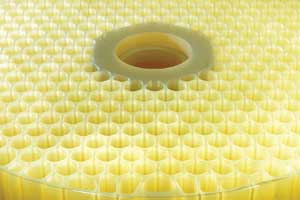
Zerodur-based substrates can be flat disks or honeycombed. Courtesy of Schott AG.
If you can stand the heat
One of the most enduring brands of glass ceramic is Zerodur from Schott AG, headquartered in Mainz, Germany. In the early 1960s, Schott began concentrating its research on glass ceramics in the LAS system. Although it began developing the material for cookware, the company found that some companies were interested in exploiting the material’s thermal expansion resistance to make substrates for telescope mirror blanks.
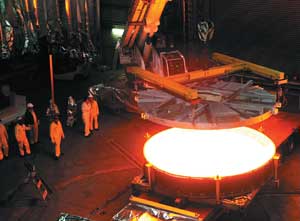
Zerodur glass ceramic as it is cast into a telescope mirror substrate. Zerodur was developed in response to a need for a 4-m mirror. Courtesy of Schott AG.
Through the 1950s, there was a bit of a turf war in the world of astronomy. By 1960, the largest telescope in then West Germany was a 1-m instrument built in 1910 at the University of Hamburg, according to Thomas Westerhoff, director of the Zerodur product division at Schott. The second-largest telescope was 72 cm and even older, having been built in 1906. Competing observatories in the US featured the much larger 5-m Hale Telescope on Mount Palomar and a 3-m telescope at the University of California’s Lick Observatory on Mount Hamilton. This disparity in telescope apertures, and thus capacity to perform cutting-edge research, nearly cost German scientists their international reputations in astronomy, Westerhoff said.
To change the situation, German academics initiated a political discussion that resulted in the foundation of the Max Planck Institute for Astronomy in Heidelberg in 1967 and a corresponding decision to fund new telescopes.
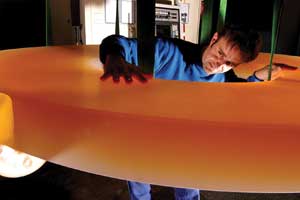
A technician checks the Zerodur-based mirror substrate destined for the Panoramic Survey Telescope & Rapid Response System wide-field imaging facility. Courtesy of Schott AG.
In 1966, Dr. Hans Elsässer, director of the University of Heidelberg observatory, approached Schott to inquire whether a 4-m mirror could be fabricated from the new low-expansion glass ceramic with which the company was working, and whether Schott had the ability to start a corresponding development and fabrication project. The manufacturer began the development of Zerodur under the leadership of Dr. Jürgen Petzoldt.
The German astronomers specified that the material to be developed should have a thermal expansion close to zero at room temperature and should fulfill additional technical requirements – such as high homogeneity and stability – needed for a large mirror substrate. After several cycles of optimization, Petzoldt finally came up with a composition that was the best choice out of a broad composition field.
Since the late 1960s, Zerodur has been applied to several industries’ needs besides astronomy and is now used in integrated chip (IC) and LCD lithography, precision measurement equipment and laser-based gyroscopes in navigation systems:
• IC lithography – Most of the demand for Zerodur is in industrial applications where high-tech equipment must maintain its dimensions, and in microlithography wafer steppers and scanners.
• LCD lithography – For flat screen televisions and other applications, ever-larger optical systems and masks are needed to project the fine microstructures for the liquid crystals that are used to control individual pixels. Because complex optical assemblies are required to create exact structures with micron resolution, glass ceramics are used for the mirrors in LCD lithography tools.
• Precision measurement – Scales and gauges made of the material are used widely because they are a temperature-independent standard for length measurement.
• Laser gyroscope – The negligible coefficient of thermal expansion and the extremely small helium permeability of Zerodur are of special importance to the laser gyroscopes used to guide ships, aircraft and space-bound rockets. Triangular or square blocks of the material formed with a ring-shaped cavity are used as thermally stable frames for the laser beam. Almost every plane uses Zerodur as part of its navigational system.
The Zerodur made today has the same chemical composition as the one invented and introduced in the 1960s, Westerhoff said. Nevertheless, it took intensive development and improvements in the manufacturing process to master challenging projects such as the four mirror blanks of the 8.2-m-diameter Very Large Telescope of the European Southern Observatory in Chile.
Ongoing research and development, the company reports, is focused on reducing the material’s weight while retaining its strength. Weight is a critical parameter when it comes to airborne applications.
ALON in the battlefield
Another well-known optical glass-ceramic is ALON, made by Surmet Corp. of Burlington, Mass. Made of a blend of aluminum, oxygen and nitrogen, ALON was developed by Raytheon Co. in the 1980s to form domes used to protect IR imagers on the battlefield. The material excelled at ballistics tests to such an extent that the results were, for a time, classified by the US government.
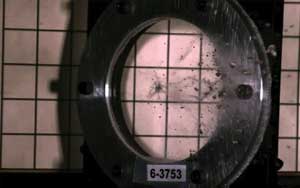
A piece of granite shatters while striking a window made of ALON glass ceramic. Courtesy of Surmet Corp.
“Once the ballistic tests were declassified, they generated a great deal of excitement in the transparent-armor community,” said Lee Goldman, vice president of R&D and chief technology officer at Surmet, which acquired the technology behind ALON from Raytheon nine years ago. “The major military applications for ALON products are in transparent armor and in infrared optics,” he added.
ALON has a cubic crystalline structure, which permits it to be processed from bulk powder into complex shapes, such as hemispheres and hyperhemispheres, as well as various thicknesses and large sizes. It is used in a range of products that include lenses, plates, rods, tubes, windows and domes. For example, domes produced with a hyperhemispherical shape are used to protect infrared countermeasures systems from environmental wear and tear, while providing a very broad field of view.
Surmet continues to develop ways to manufacture and use ALON, taking cues from its clients. The company has tweaked the internal architecture of the crystalline structure at the behest of its customers; with the support of one government agency, it also is developing a version of ALON with tailored gradient refractive index profiles, Goldman said.
Clearly driven by customers
Ohara Corp. of Somerville, N.J., makes Clearceram, another glass ceramic leader in the LAS system classification. Known for its high homogeneity, thermal properties and precise crystalline structure, Clearceram is found in steppers for LCD and other semiconductor manufacturing, interferometers, laser mirrors and other optical components. Ohara cites its mastery over the crystallization process for the material’s near-zero thermal expansion coefficient (see table).

As with Schott, Surmet and other glassmakers, Ohara continues tweaking its most popular product. Clearceram is available in several iterations, each with a more highly tuned thermal stability.
Optical material development at Schott is driven chiefly by market conditions and customer demand, according to Westerhoff. Ideas are generated in close cooperation with client companies, universities and relevant industrial organizations, he said, and new materials are designed toward target specifications, including cost. For the company, close cooperation with customers is essential to secure success.
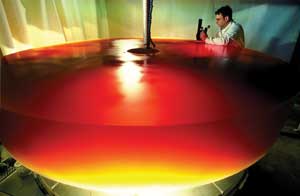
Zerodur glass ceramic optical material. Courtesy of Schott AG.
Surmet’s Goldman concurs with the need to attend to clients and applications. “We are customer-focused. We produce materials solutions that our customers are not able to find elsewhere,” he said.
As with optics made of glass, silicon and other materials, optics made of glass ceramics must meet ever-changing needs and increasingly stringent demands for quality and durability. These evolving criteria will shape future versions of glass ceramics and perhaps one day lead to their replacement with exciting new materials yet undreamed of.